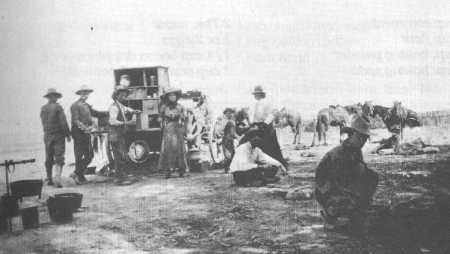
Quoting from "Camping it Up" by Patricia Sharpe:
Charles Goodnight; the blazer of the Goodnight-Loving Trail invented the Chuck Wagon.
After the demise of the Buffalo; he went into the ranching business. Early
steers were the Longhorn breeds who could survive the arid fields of the West Texas
prairies. Having an open range and no transportation to the cities and towns [the
market] only thing to do is drive the cattle to the customer.
These drives took many days and nights on the trail; necessitating carrying your food
and bed rolls with you. Goodnight took an old army wagon, bolted a cupboard to the back
and loaded it with groceries of the day along with the bedrolls, and sent his
crew across the country to deliver the herd. The concept worked wonderfully and
spread throughout other ranches; one result of that is our "Chuck Wagon Gang"
and its' celebrated feeds all over the world. The latter one was in Odessa, Ukraine,
1998. More details on this hard working, fun loving group later.
Historical Data:
Lila Box White helps us remember cooking the old fashioned way on the chuck wagon like
Earl Tripp did countless times.
"Earl Tripp, the third of the six sons of Mr. & Mrs.
Tom Tripp, helped his mother with the housework and the younger boys. Learning to cook
gave him good training to man the chuck wagon for the cattle roundup when he was
older."
"The chuck wagon carried provisions for the group. Some of them were covered, but
many things had to be wrapped in tarps, large pieces of heavy canvas covered with a thin
coat of tar or paint called tarpaulin. Food and water were often protected by these
covers. On the back of the wagon was a wooden cabinet for cooking materials such as salt,
pepper, lard, sugar and spices. Blue enamel plates and cups as well as heavy tin knives,
forks and spoons were found there. The back of the cabinet was a door on hinges that 'let
down' to provide a table for preparing and serving food."
"Flour was stored in five gallon tin cans. Onions and potatoes were carried in
bushel tow sacks made of coarse brown thread. Chow was extremely limited as there was no
way to keep food cool. Brown beans were cooked in large enamel pots and were one of the
most common foods. They could kill a beef for meat. Biscuits and water gravy were popular
with the meat. As they could carry dried fruit, fruit cobbler was a favorite."
"Food was cooked outside over a bed of coals left after a wood fire had 'died
down'. Large heavy utensils were necessary; iron skillets, thick enamel pots and shallow
metal pans for biscuits and cobblers. Long handled forks and spoon must not be forgotten.
Food was taken directly from the cooking containers by the cowhands."
"In addition to the care and preparation of food, the cook was responsible for
loading and unloading the chuck wagon when the group moved their roundup location. All
supplies and their care and protection were his for the duration of the trip. So it was no
small task to be cook and caretaker for a group of cowhands as Earl
Tripp was, near Odessa In West Texas during the 1920.s"
Any one have details on this Photograph? We are on a unknown ranch in 1900's
Courtesy: The Flavor Of Odessa, 1891-1991; editor:Ann Sherburn.
The Heritage of Odessa Foundation.
Clear Page
Updated: May 23, 1998
